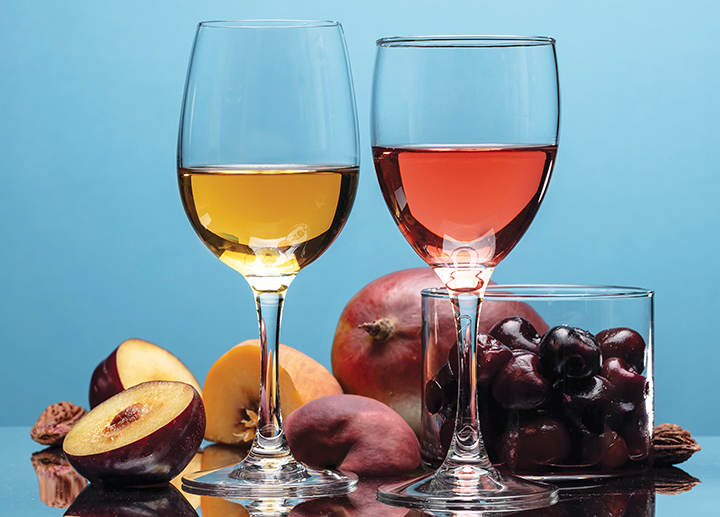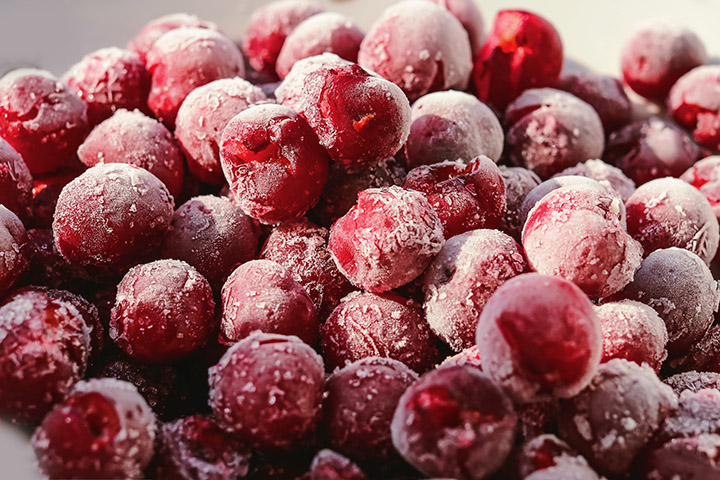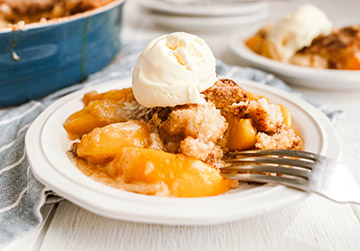Possibly the ancestor of all alcoholic beverages, mead has been enjoyed by audiences across history — from humble working folk to soldiers, pirates, and even royalty. And while its popularity waned in recent centuries, over the last decade or so there has been a resurgence in interest in making this ancient, golden-hued drink.

Mead is also sometimes called honey wine because it is, in its most basic form, a beverage of similar strength to wine that gets its sugar from honey. Of course, there are numerous variations of mead that differ based on honey source as well as the addition of spices, grains, fruits, and other ingredients that allow for an exploration of creativity.
In this piece, it’s the fruit bit that we will be concentrating on — specifically stone fruit — with the expectation that you already know the very basics of meadmaking (though if you don’t, start here for a good overview of the general process: www.winemakermag.com/article/497-mead-from-nectar-to-nirvana.
Stone fruits, scientifically classified under the genus Prunus, are a type of fruit characterized by their fleshy exterior and a hard “stone” or pit inside, which houses the seed. They are commonly known as drupes. These fruits are known for their juicy, sweet, and sometimes tart flavors, which makes them popular choices for fresh consumption as well as making fruit meads (melomels) of diverse flavors.
Examples of the more common drupes that we all know are mangoes, nectarines, peaches, plums, cherries, and apricots. Some that may not be as obvious include pecans, amlas (Indian gooseberries), blackthorn (Prunus spinosa) and ivy (Hedera helix).
Stone fruits are versatile and can be used in meadmaking by combining the juice with other flavors and fruits (more on this later) or used with a single honey variety for a straight-forward mead. Alcohol percent can also range from high-octane still meads that finish dry and have tremendous aging potential, to lower-alcohol beverages (often carbonated) that drink as light and refreshing with more retained residual sweetness.
No matter the style, making the best stone fruit mead requires the best fruits at optimum ripeness. If you live in an area where these fruits are grown, you have a big advantage as you can use the freshest fruits. That said, there are many other options from canned and frozen fruits to purees that can also have good results. Any of these other choices would be far better than using subpar fruit that you don’t want to eat. Expecting a resulting mead to taste better than the sum of its parts is a fool’s game. And let’s face it: The price of honey is too high to gamble with fruit that has visible mold, wildlife damage, or significant bruising. Though you may be able to find fruit for a discounted price simply for aesthetic deformities, which is a great way to use up perfectly good-tasting fruit.
Sugar Levels of Stone Fruits
Stone fruits vary in their natural sugar content, based on factors such as variety, growing conditions, and ripeness. Now, why is it important that we consider the sugar levels of our stone fruits for meadmaking? Well, besides the fact that it directly adds to the sweetness and flavor, sugar is the main component that ferments in your mead. Because honey is the primary source of sugar in mead — even fruit mead — this isn’t a huge factor, but the more sugar the fruit has the less honey will be needed to hit your target starting gravity. There are numerous sources for average sugar content of fruit online. One I have used is www.sugarnutritionresource.org. Here’s a look at the average sugar content from the WineMaker website of the most common stone fruits used in meadmaking:
• Sweet cherry (9–13 °Brix)
• Peach (8–9 °Brix)
• Nectarine (8–9 °Brix)
• Plum (6–8 °Brix)
• Apricot (6–7 °Brix)
As a winemaker, you know that averages are just a starting point when it comes to a fruit’s sugar content. As an agricultural product, the actual sugar content will vary from place-to-place, or even tree-to-tree, based on weather patterns and growing conditions. So the best way to get the most accurate measurement is to test the juice using a refractometer the same way you would grapes. With a fruit like cherries, get a handful and crush them together in a Ziploc bag. Wait a while and then take a sample. With larger fruits, cut slices of a bunch of pieces and follow a similar process.
What’s the Recommended Amount of Fruit to Be Used Per Batch?
Depending on the flavor intensity and the type of stone fruit being used, the recommendation varies on just how much fruit you’ll need for a batch of mead. However, on average, 1–3 lbs. per gallon (120–360 g/L) works well with most fruits. After using this as a starting point, you might leave it for a week and then have a tasting session to see if you want to add more fruit or not. In my experience, I have found 2 pounds (0.9 kg) of stone fruit per gallon (3.8 L) to work to give me the perfect flavor. The fruit itself and your palate will have an impact on the perfect amount for your mead.
Fresh, Canned, or Frozen Fruit?
All of these fruit forms yield good results in your mead, but there are some distinctions you must note.
In my first three years of making peach, plum, and cherry meads, I used canned fruits because it was available year-round. It wasn’t until I went to an open fruit market that I experienced a different taste and degree of tartness in my final product. Fresh fruit is natural, so it is usually less sweet or more tart depending on ripeness, which can be adjusted in the recipe to balance sweetness. You have full control on how it’s processed: Adding of extra sugars or not, freezing or not, removal of skin/seed removal, etc. It’s all your choice. However, the seasonality of fruit means they aren’t available year-round, plus you will have to spend more time cutting, depitting, etc. Just like choosing fruit to eat, most would agree fresh is going to taste best, but the trade-off of time and effort are real considerations.
The canned fruit form is usually available throughout the year, although they often contain added sugars, syrups, and preservatives. I have enjoyed the meads made with canned fruit, and another benefit is a consistent flavor profile for the most part, though they don’t have the same taste as perfectly ripe, fresh fruit.
Another option is buying frozen fruit. It is similar to fresh fruit (though, again, nothing beats fresh tastewise). You don’t get the added ingredients that often come with canned fruits, and the fact that the fruit is frozen actually makes working with the fruit easy. Why? Well, freezing fresh fruit is a step I recommend anyway, which we’ll discuss in the next section.
Processing

Processing stone fruits for meadmaking involves several steps to extract flavors effectively and prepare them for fermentation. They are slightly more labor-intensive than most fruits because the pits need to be removed, and the size of many of the fruits means you can’t just crush them as you would a softer berry. Following are the processing steps I take:
Choose Ripe Fruit: The same fruit that is the best flavor for eating is the best fruit for meadmaking. Select ripe, preferably local and freshly picked, fruits for the best flavor. For peaches and nectarines, your nose will tell you when they are ripe. They will emit a sweet – almost floral – aroma. You can also do the pressure test. This is how you can select a ripe plum — take the stem and gently apply pressure. If it yields, you know it’s ripe and ready to go.
Rinse: Give the fruit a thorough rinse to remove any dirt, bugs, or residues.
Depitting: Before you freeze your fruits, it’s advisable to remove the pits, especially for plums and other fruits that have large seeds. This is because if you decide to crush the stones or leave them in contact with your fruit for fermentation, it could cause a bitter taste (because of the presence of a bitter compound in them, amygdalin). Also, isn’t it just easier to process without a stone to battle with?
Freezing: An important processing step for fresh stone fruits is to freeze for 24–48 hours. This will not only slow and retard the growth of bacteria that may be on the fruit, but releases the flavor much easier during fermentation. When fruit is frozen, the water inside the fruit cells forms ice crystals. These crystals expand and rupture the cell walls. When the fruit is thawed, these ruptured cells release more of their internal juices and flavors into the mead. This process increases the extraction of flavors from the fruit as the cellular structure is broken down, allowing more of the natural compounds to mix with the mead.
Chopping, pureeing, or juicing: After freezing and thawing, it’s recommended to cut the fruit into smaller pieces or crush the fruits well using whatever device is at your disposal. Another option is pureeing the fruit into a smooth paste by using a blender or food processor. If you have a juicer, you can juice the fruit and add the juice to your fermenter as well. For more information on working with purees, read: www.winemakermag.com/article/1766-fruit-wines-from-puree.
Additional Ingredients to Add
While making your own melomel, rather than just the basic mixture of honey, water, yeast, and fruit, why not take it a step further with ingredients to enhance flavor and complexity? Of course, the variety of honey used is important and should complement the fruit you choose. Wildflower and orange blossom honeys are usually safe bets for these types of meads, but don’t be afraid to play around with some more exotic honey varieties that may add to the experience.
Beyond honey variety, here are few ingredients that often pair great with stone fruit meads:

Spices: Cinnamon sticks, cloves, nutmeg, allspice, ginger, vanilla beans, and star anise are just a few of the spices that could be added to your mead. However, the options are vast and can range from floral additions like chamomile, to exotic choices like cardamom or even chili peppers for a spicy kick. If you haven’t experimented before, a good place to start is thinking about some of your favorite dishes. Love peach cobbler with cinnamon and a little nutmeg served with vanilla ice cream? Sounds like a good combination for mead too!
Once you pick the spices to complement your mead, consider when and how much to add. If you want a more pronounced spicy aroma and flavor by the time your mead is ready for consumption, then it is recommended to add spices during the secondary fermentation or aging process. You should carefully consider the appropriate quantity to be added for each spice, as these spices should complement the taste of your stone fruit mead, not overwhelm it. Some spices, like cloves or cinnamon can be quite potent while others like vanilla or ginger can add depth without dominating. Do trials if possible, and remember that more spice can always be added, but once too much is added it can’t be taken out.
Herbs: Herbs also add a spectrum of flavors and aromas that complement and enhance the natural sweetness of mead. Some of the spices listed earlier could also be classified under herbs. Some other popular herbs include lavender, chamomile, and rosemary, all of which add specific subtle floral notes to complement your honey; chamomile imparts a soothing, apple-like flavor and rosemary gives a piney note with hints of citrus.
Citrus zest: Speaking on citrus, citrus zest is prepared by scraping or cutting from the rind of unwaxed citrus fruits such as lemon, orange, and lime with the use of a micro plane or a fine grater. Zest adds bright, tangy flavors to your mead that often complement the honey perfectly. They could also be added during secondary fermentation or aging. Just be sure to leave the pith (the white layer beneath the outer peel) as it is very bitter.
Other fruits: Who said a stone fruit melomel should only contain these types of fruits? Throw in some raspberries, blackberries, or even apples for that cyser blend. There are a lot of combinations that work well together. A fun trial to see how they will taste together in a mead is to buy an assortment of fruits and try eating them in different combinations.
Oak: Oak chips and cubes are readily available and convenient for home winemakers. Oak chips have more surface area and can impart flavors faster, while oak cubes release flavors more slowly due to their density. As winemakers are aware, there are also different oak types; American oak tends to add stronger vanilla and coconut notes, while French oak is known for more subtle spice and tannin. Consider the mead and the flavors you wish to impart with the oak to make your choice.
Yeast nutrients: While honey provides essential nutrients for yeast, ensuring a robust fermentation process often requires supplementing with yeast nutrients.
Two popular nutrient options are Fermaid O and Fermaid K. Fermaid O is an organic blend of yeast hulls and vitamins, and Fermaid K an inorganic combination of diammonium phosphate, yeast hulls, and other nutrients designed to support yeast health during fermentation. Fermaid O is more suited for delicate meads and Fermaid K is better used for robust or high-ABV meads.
Yeast nutrients can be added directly into your honey and water mixture (must), when pitching the yeast, but ensure you mix the nutrient with a small amount of warm water first before adding it to the must to minimize the risk of clumping.
Pectic enzyme: In this article, we are dealing with fruits just as much as we’re dealing with meads, so of course we have to talk about this important fruit enzyme. Pectinase is crucial for the breakdown of pectin, a complex polysaccharide in fruits, into simpler molecules.
During your fermentation process, pectin tends to cause cloudiness and haze in the mead leading to a turbid appearance. This is where your pectic enzyme clears things up and reduces turbidity. Pectinase could also function in breaking down fruit cell walls, releasing trapped nutrients, sugars, and aromatics in the must. Typically, you should add pectic enzyme during the initial stages of mead preparation (primary fermentation stage). Learn more about pectic enzymes at www.winemakermag.com/article/using-pectic-enzymes.
Ready to make a stone fruit melomel? Following are two recipes that put much of the information covered here to use. Feel free to experiment and tweak them to your own tastes —that’s what the hobby is all about!
Peach Melomel

(2 gallons/7.6 L)
OG = 1.116 FG = 0.990
ABV = 16.5%
There are many ways of making a stone fruit mead, and they range from using fresh fruit to buying canned fruit, to juicing your fruit or buying the juice itself. This peach melomel recipe, which will be using canned peaches and Tupelo honey, is just one of the many ways to make a peach mead. It’s a good introductory recipe that is relatively easy and results in tasty mead. Feel free to substitute fresh peaches if they are in season.
Ingredients
3 lbs. (1.4 kg) canned peaches
1.5 lbs. (0.68 kg) Tupelo honey (or similar)
3 lbs. (1.4 kg) clover honey (or similar)
6 g Fermaid O
Potassium sorbate and metabisulfite
1 tsp. pectic enzyme
Water up to target starting gravity (~7 quarts/7 L)
5 g Red Star Premier Classique yeast
1 lb. (0.45 kg) orange blossom honey (for backsweetening)
1⁄2 Tbsp. vanilla extract.
Step by step
Sanitize all your equipment and mix together the peaches, Tupelo and clover honeys, and add warm water up to about the 2-gallons (7.6-L) mark. Measure the gravity. The target is 1.116 (27.2 °Brix). There will be some variability based on the fruit and honey used, so either add more water if the gravity is too high, or more honey if too low. Mix well, add rehydrated yeast, Fermaid O yeast nutrient, and pectic enzyme. Ferment at room temperature until complete, around one month.
When complete, strain the peaches out or rack off of them and stabilize with potassium sorbate and potassium metabisulfite to prevent further fermentation. This will keep the mead from refermenting when backsweetened. Backsweeten by stirring in the orange blossom honey and vanilla extract.
After backsweetening, wait 2–4 weeks to allow flavors to integrate and stabilize before bottling. Rack off sediment and ensure specific gravity is stable to confirm fermentation is complete. Bottling can proceed with clean, sanitized containers, leaving 1⁄2 inch (1.2 cm) headspace, and storing upright in a cool, dark place for at least six months to one year before serving.
Viking Blood (Cherry Melomel)

(1 gallon/3.8 L)
OG = 1.092 FG = 1.000
ABV = 12.9%
This is a cherry melomel named after the seafaring Nordic legends — the Vikings — from where it originated. So, if not for anything, make this mead simply for the lore. The honey, sourced from hives kissed by Nordic breezes lends its essence, while the cherries impart a tartness that balances its sweetness with a tantalizing acidity.
Ingredients
3 lbs. (1.4 kg) honey (preferably a darker variety for depth of flavor)
1 gallon (3.8 L) water
5 g Champagne yeast
1 lb. (0.45 kg) cherries (pitted and crushed)
1 oz. (28 g) dried hibiscus flowers
Step by step
Mix honey into warm water to dissolve. Add crushed cherries and dried hibiscus flowers and then pitch Champagne yeast. Ferment at room temperature for 4–6 weeks, or until fermentation is complete.
Rack off fruit and hibiscus and ensure specific gravity is stable to confirm fermentation is complete. Bottling can proceed with clean, sanitized containers, leaving 1⁄2 inch (1.2 cm) headspace, and storing upright in a cool, dark place for at least six months to one year before serving.







